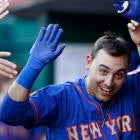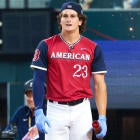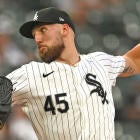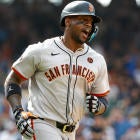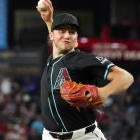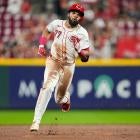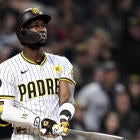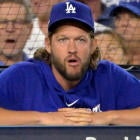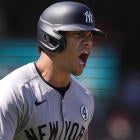More Fantasy Baseball: Surprising old guys: Can it last? | Prioritizing breakout pitchers | Waivers: Romero is real deal
You're worried. Not only have you lost your ace, but your best bats are struggling. Is it time to panic? Should you sell everything that isn't nailed down?
No. Calm down. Don't panic. You'll be fine. Your team will be fine. Here are six players off to slow starts, and the reasons to still be optimistic
We'll start with an easy one. In Anthony Rizzo's case, it's not so simple as to point at his .169 BABIP and say nothing else, but it isn't far off. Rizzo hasn't had much luck, but he also isn't helping himself much, walking just 3.7 percent of the time while sporting a .125 ISO through 23 games — both of which would obviously be career lows for a full season. This isn't just bad luck, either, because Rizzo just hasn't been hitting the ball particularly hard, ranking just 196th in average exit velocity on line drives and fly balls.
- Subscribe to the Fantasy Baseball Today podcast for free on Apple Podcasts, Stitcher, TuneIn, Google Play or anywhere else you listen.
So what's the silver lining? At the risk of being reductive … it's Anthony Rizzo! He slumped even longer last season, sporting a .213/.351/.383 line on May 14 last season. We're already seeing him start to dig out of this hole, with three homers in his last five games. No, there's nothing wrong with Anthony Rizzo.
Another year, another disappointment from Gregory Polanco, right? Not quite. Sure, Polanco's .740 OPS looks a lot like the disappointing guy he's been throughout his career, but he's actually playing exceptionally well in the early going. He has nearly doubled his walk rate from 2017, and his .215 ISO stands as the best mark of this career. His 35.2 percent hard-hit rate shows there's nothing flukey about the power, and even the career-high strikeout rate is mostly in line with what he posted in 2016. No cause for alarm there.
So, why is Polanco such a disappointment? The .224 BABIP explains most of it. More than 2,000 plate appearances into his career, Polanco has a .286 BABIP, so it's fair to assume he probably won't regress to even league average there. However, if we correct Polanco's BABIP to his career norm and give him all singles, his line would look like this: .256/.368/.470. Or, roughly what Paul deJong has managed. We'd be talking about that breakout finally happening, instead of fielding questions about whether he's worth rostering. Yes, he is.
When you look up the average exit velocity leaderboards on BaseballSavant.com, you don't have to go far to find Marcell Ozuna: Among 250 players with at least 50 batted ball events tracked by Statcast, Ozuna ranks 14th in baseball in average exit velocity. He is, once again, hitting the ball hard, and doing so consistently, ranking 17th in rate of batted balls over 95 mph.
So, what's the problem? He's hitting all of those balls into the ground. That's bad news for worms, but good news for defenses. Ozuna ranks eighth in the majors in average exit velocity on groundballs, but just 161st on line drives and fly balls. Ozuna has always been more of a ground ball hitter than you would think for being an impressive slugger, but that issue has grown even more pronounced. The good news is, he's probably had a bit of bad luck (7.1 percent HR/FB rate), and there's no obvious sign of injury either. This seems like a relatively small tweak to make. I would buy if his current owner was looking to sell.
Matt Olson is more than halfway to his games played total from his rookie season, and he is… not halfway to his homer total. He hit 24 in 59 games a year ago, but has just four in 35 games in 2017. He's also striking out and swinging-and-missing more often, so it seems pretty clear there's something going wrong here, right?
Only if you really though Olson was a 50-homer threat in his first full season. He was always going to be a hitter with some swing and miss in his game, and you would live with it because he hits the ball hard when he hits it. The results haven't been where you hoped they would be, but he's still hitting the ball very, very hard; he has a 50.6 percent hard-hit rate while ranking in the top-25 in average exit velocity both overall and on fly balls and line drives specifically. And he's hitting plenty of line drives and fly balls, so there's no concern there. You'd like to see him pull the ball a bit more, but other than there, there really isn't anything alarming in Olson's batted-ball profile. The homers are coming.
And thus concludes the portion of the program with comforting answers. Michael Conforto's injury provides us an easy explanation for why he has struggled, but also serves as a glaring argument for why he may not be right this season. Digging into the numbers, Conforto certainly looks like someone who doesn't feel comfortable swinging as he returns from shoulder surgery: his overall swing rate is down to 39.9 percent, the lowest of his career, and he's offering at pitches both within and outside of the strike zone less often.
That's not necessarily a bad thing — his walk rate is up! — but Conforto isn't doing much when he does swing the bat. He homered in his first game back, and he homered Monday against the Reds, but he had done next to nothing else. Conforto's hard-hit rate has collapsed to 31.5 percent from a 40.1 percent career mark, and he ranked just 183rd in the majors in average exit velocity.
The good news? Well, he's healthy enough to play! I can't say for sure he'll turn it around. All I can say is, Conforto is the kind of talent I want to bet on, especially the further removed he gets from surgery.
For most of his professional career, Scott Kingery didn't hit for power. Of his 34 career minor-league homers, Kingery hit 18 of them in one 69-game stretch at Double-A last season; he followed that up with eight in 63 at Triple-A. I was skeptical the power was for real, but I also figured the rest of his skill set would transfer: The bat-to-ball ability, speed and batting average skills would play even if the power didn't.
As it turns out, it's harder to hit in the majors than it is in the minors. After never striking out more than 21.7 percent of the time in any minor-league stop, Kingery has gone down on strikes in 27.4 percent of his trips to the plate in his first 31 games. He just hasn't commanded the strike zone particularly well, swinging at 39.2 percent of pitches out of the strike zone, the 12th-highest rate in baseball.
That just isn't what we expected from him, and it's disappointing to see. However, Kingery has shown some intriguing skills that point to better days ahead, specifically with a 33.8 percent hard-hit rate. Just 5.7 percent of his fly balls have gone over the fence, a rate that is far lower than expected given his hard-hit rate and home park. Part of the issue is a troubling propensity toward infield fly balls, but Kingery is still hitting the ball better than his numbers show. He's a solid buy-low candidate, because a breakout could come quickly if he gets the bat on the ball more frequently.



















